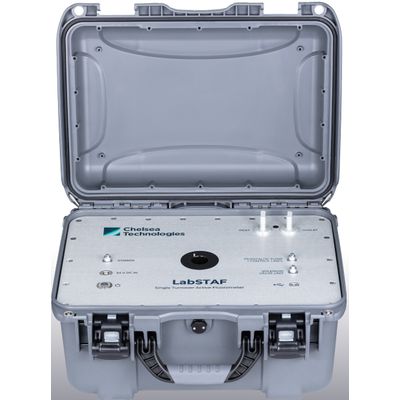

- Home
- Companies
- Chelsea Technologies Ltd
- Products
- High Biomass LabSTAF - Measure ...

High Biomass LabSTAF - Measure Phytoplankton Primary Productivity
Phytoplankton primary productivity (PhytoPP) assessment for industrial algae producers. LabSTAF HB is the latest product in our range of next generation of STAF-based instrumentation to evaluate phytoplankton primary productivity, specifically designed for high biomass applications such as industrial algae production.
- Choose the optimum time to harvest by monitor trends in active fluorescence parameters
- Monitor biomass accumulation to gauge how well your culture is performing
- Identify issues or contamination events early and take action to harvest early or rectify by monitoring for unexpected changes
Key features
- The use of high performance, hard-coated optical filters removes the need for filtrate blank correction in most cases
- The provision of two fluorescence detection wavebands allows for quantification of and correction for the package effect through the Dual Waveband Measurement (DWM)
- The inclusion of seven fluorescence excitation LED wavebands allows for rapid and highly automated spectral correction by generating the Photochemical Excitation Profile (PEP)
- An integrated actinic light source providing 10 to > 1600 µmol photons m-2 s-1. The light source is driven by DC to avoid the potential for measurement artefacts associated with Pulse Width Modulation (PWM)
- The sample chamber block includes a circulating water jacket that avoids intersection with all optical paths to allow for the use of underway water for sample temperature control
- FLC automation includes dynamic optimisation of the FLC protocol using a new method for continuous assessment of the Ek parameter
- Real time data analysis provides 39 fluorescence parameters, in addition to the standard FLC parameters, and including options for the correction of baseline fluorescence
- A wide range of export functions to provide access to primary data. They can be used to extract data from a single file or across multiple files
Applications
- Optimising harvest through productivity trend analysis
- Monitoring biomass accumulation to gauge culture performance
- Monitoring for and early identification of any contamination and other issues that may impact on the algae culture
- Monitoring pond cultures
Active Fluorometry
The two most common fluorescence-based methods used to probe photosynthesis are Single Turnover Active Fluorometry (STAF) and the Multiple Turnover Pulse Amplitude Modulation (PAM) approach. The STAF method is by far the best option for making measurements from optically thin suspensions of phytoplankton (as found in the world’s oceans and most lakes and rivers) while the PAM method is suited to samples with high optical density (such as macroalgae and seagrasses).
The Fluorescence Light Curve (FLC)
For many users, the most important application of LabSTAF is the fully automated acquisition of consistent Fluorescence Light Curve (FLC) data from cultures or natural samples. The combination of LabSTAF hardware and RunSTAF software allows for the highly automated acquisition of FLCs, with options for real time light step adjustment, automated sample exchange and system cleaning. As an example, these features have been used to run LabSTAF systems continuously for several weeks while plumbed into the underway water supply on board research vessels.
Rapid screening of multiple samples
Although a great deal of effort has been applied to the development of FLC automation, the system allows for much shorter automated protocols to be run. A manual control option is also available to the user. The large sample chamber provides a range of options when using these features. One option is to pour a sample of between 10 and 20 mL directly into the sample chamber. Alternatively, rapid measurements can be made from smaller samples within scintillation vials.
LabSTAF, primary productivity and the dual incubation method
Primary productivity by phytoplankton (PhytoPP) accounts for approximately half of the carbon fixed by photosynthesis on a planetary scale. While satellite remote sensing of ocean colour operates on the widest possible spatial scales and is arguably the only means to assess PhytoPP in the context of global biochemical cycles and climate, the algorithms used to estimate PhytoPP from satellite data rely on large datasets of in situ measurements. The established reference for quantifying PhytoPP directly is the 14C tracer-based approach which falls short of providing data at the required temporal and spatial resolution. The scarcity of in situ PhytoPP measurements has been limiting the development and validation of remote sensing algorithms of PhytoPP and is preventing adequate parameterization in regional and global ecosystem and climate models. STAF, as an optical method, can assess PhytoPP autonomously at vastly higher spatial and temporal resolution and at a fraction of the cost of 14C tracer-based methods.
While 14C tracer-based methods measure carbon fixation directly, STAF measures the rate at which the reducing power required for carbon fixation is provided by Photosystem II (PSII) photochemistry. RunSTAF has been optimized for improved estimates of this rate and incorporates highly automated protocols to allow for Package Effect Correction (PEC) and spectral correction through application of a Photochemical Excitation Profile (PEP). Additional data processing tools to correct for baseline fluorescence (from sources other than photochemically active PSII complexes) are also included within RunSTAF.
STAF-derived values of PSII photochemistry can be converted to rates of carbon fixation through the electron to carbon ratio (Φe,C). Determination of this ratio requires parallel STAF-based measurement of PSII photochemistry and 14C tracer-based measurement of carbon fixation. The large sample chamber incorporated within LabSTAF allows for the use of 24 mL scintillation vials, enabling 14C-spiked samples to be used to assess carbon assimilation in parallel with STAF measurements. Development of this ‘dual incubation’ approach has removed many of the methodological inconsistencies that have inhibited practical assessment of the number of electrons (assessed through STAF) required to fix each carbon (assessed through 14C-fixation). While such dual incubations cannot be performed at high resolution, representative measurements made within a specific environment will provide values that improve the accuracy of the conversion between PSII photochemistry and carbon assimilation.
